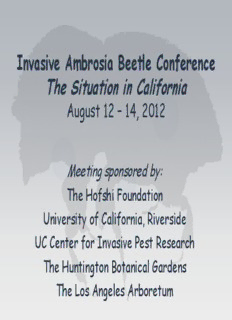
Uncommon but significant phytopathogenicity is exhibited by some PDF
Preview Uncommon but significant phytopathogenicity is exhibited by some
Invasive Ambrosia Beetle Conference The Situation in California August 12 – 14, 2012 Meeting sponsored by: The Hofshi Foundation University of California, Riverside UC Center for Invasive Pest Research The Huntington Botanical Gardens The Los Angeles Arboretum Invasive Ambrosia Beetle Conference The Situation in California August 12 – 14, 2012 Session 4 Biology of the Fungal Symbiont Uncommon but significant phytopathogenicity is exhibited by some ambrosia beetle symbionts Randy C Ploetz University of Florida Tropical Research & Education Center 18905 SW 280th Street Homestead, FL 33031-3314 [email protected] • These diseases are unexpected, due to the unusual behaviors of the vectors and atypical phytopathogenicity of the symbionts • These diseases are unexpected, due to the unusual behaviors of the vectors and atypical phytopathogenicity of the symbionts • Due to their uncommon attributes, they are unpredictable • These diseases are unexpected, due to the unusual behaviors of the vectors and atypical phytopathogenicity of the symbionts • Due to their uncommon attributes, they are unpredictable • Although they are abnormal, they can have extreme impacts on forest, landscape and agricultural trees Japanese oak wilt Laurel wilt Fusarium canker Sporothrix + platypodid on black walnut damage on Eucalytpus nitens Fusarium dieback of avocado Korean oak wilt Table 1. Examples of ambrosia beetle‐associated damage to trees Species Host tree(s) Symbiont(s). Host impact Leach’s rules? References Platypodinae: Platypodini Austroplatypusincompertus Eucalyptus Ambrosiellasp. Wood quality degraded in living trees with No Kent, 2008; Finnegan, 1967; an unclear involvement of symbiontor other fungi Baker, 1972 Euplatypusparallelus Pterocarpusindicus Fusariumoxysporum. Lethal wilt. Symbiotic relationship with No Bumrungsri et al., 2008 beetle suggested, but Leach’s rules not fulfilled Megaplatypusmutatus numerous Raffaeleasantoroi. Mortality with no symbiontimpact n/a Alfaro et al. 2007; Smith, 2009 reported Platypus quercivora Quercuscrispula, Q. serrata Raffaeleaquercivora. Japanese oak wilt. Mortality in Yes Murata et al., 2009; Kinuura and susceptible species after mass attack by vector Kobyashi, 2006; Kamata et al., 2002; Urano, 2000 Platypus koryoensis Quercusmongolica, Q. alienaand Raffaeleaquercus‐mongolicae. Korean oak wilt. Mortality in Yes Kim et al., 2009; Lee et al. 2011 Q. serrata susceptible species after mass attack by vector Platypus cylindrus Quercussuber Ophiostomaquercumand other Ophiostomatalesrecovered No Belhoucine et al. 2011 from beetle, but Koch’s postulates and Leach’s rules not fulfilled Platypus apicalis, Platypus Nothofagusmenziesii, N. solandri Sporothrixnothofagi. Mortality and/or reduced wood Yes Milligan, 1972; Faulds, 1977; gracilis, Treptoplatypus var. cliffortioides, N. fuscaand N. quality caused by symbiont Wiser et al. 2005 caviceps(formerly Platypus truncata caviceps) Scolytinae: Xyleborini Corthyluscolumbianus Numerous angiosperms in eastern No apparent role for symbiontor other fungal associates. n/a Baker, 1972; Kabirand Giese, U.S.A. Prefers vigorous living Causes significant economic degrade of timber. 1966; Kuhnholzet al., 2003; Nord hosts. and McManus, 1972 Corthyluspunctatissimus Diverse angiosperms in eastern No apparent role for symbiont. Lethal to young Acer n/a Baker, 1972; Finnegan, 1967; North America saccharum, which is girdled at root collar Kuhnholzet al., 2003 Corthylussp. Alnusplantations in Colombia Pathogenicity documented for associated fungi, Fusarium No Zulmaet al., 2004 solaniand Ceratocystissp. Euwallaceafornicatus Camellia sinensisand other Fusariumambrosium Yes Anonymous, 2012; Brayford, angiosperms 1987; Sivapalan, 1978 “Euwallaceafornicatus” Perseaamericanaand other Fusariumsp. causes branch dieback and is disseminated by Yes Eskalen et al., 2012; Mendel et angiosperms what may be distinct relatives of E. fornicatus al., 2012 Xyleborusglabratus Perseaamericana, P. borbonia, P. Raffaelealauricola. Laurel wilt. Lethal development in Yes Fraedrichet al., 2008; Harrington humilis, P. palustris, susceptible species after a single inoculation et al., 2008; Ploetz et al., 2012 Xylosandrusgermanus Juglansnigra, Liriodendron Fusariumlateritium, F. solani(Ambrosiellahartigiimay be No Alamoutiet al., 2009; Anderson tulipifera, Quercusrubra primary symbiont). Cankers and severe damage on trees in and Hoffard, 1978; Dochinger nurseries, but Leach’s rules not fulfilled. and Seliskar, 1962; Kessler, 1974 There are more species of beetles (the Coleoptera) than any other order in the animal kingdom (25% of all known life- forms) Bark beetles are phloem feeders
Description: